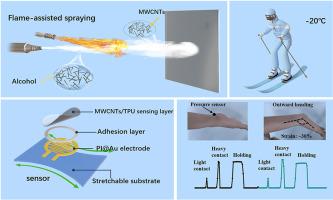Highly Sensitive yet Strain-Insensitive Flexible Pressure Sensors Based on MWCNTs/TPU Composites for Wide-Temperature-Range Applications
IF 4.5
2区 化学
Q2 POLYMER SCIENCE
引用次数: 0
Abstract
Strain-insensitive flexible pressure sensors can conform to dynamically changing and complex surfaces while avoiding pressure-strain coupling artifacts, making them highly valuable for applications such as monitoring human body activities. However, despite various fabrication methods that have been proposed, large-scale manufacturing remains associated with high cost and low efficiency, and the resulting devices may lose functionality in low-temperature environments. In this study, a large-area MWCNTs/TPU sensor layer was fabricated using a sandpaper template combined with a flame-assisted spray technique, achieving low cost and high sensitivity. A high-modulus polyimide@Au (PI@Au) electrode layer was integrated with a low-modulus, highly elastic, and anti-freezing polyurethane substrate. The resulting sensor exhibits ultrahigh sensitivity (∼629.9 kPa-1 in the range of 0.3–28 kPa), a fast response time (10 ms), and excellent stability over 1000 repeated cycles. It maintains high sensing accuracy across 0%–50% strain, with sensitivity variations of only ∼5.2 %, ∼4.1 %, and ∼3.6 % between the 0% and 50% strain states in the low-pressure (0.3–28 kPa), medium-pressure (28–80 kPa), and high-pressure (80–320 kPa) ranges, respectively. Reliable signal detection is preserved even at −20 °C under up to 50% strain. This work is expected to facilitate the application of stretchable pressure sensors on deformable interfaces and expand their operational temperature range.

基于宽温度范围应用的MWCNTs/TPU复合材料的高灵敏度应变不敏感柔性压力传感器
应变不敏感的柔性压力传感器可以适应动态变化和复杂的表面,同时避免压力-应变耦合工件,使其在监测人体活动等应用中具有很高的价值。然而,尽管已经提出了各种制造方法,但大规模制造仍然与高成本和低效率相关,并且由此产生的设备可能在低温环境中失去功能。本研究采用砂纸模板结合火焰辅助喷涂技术制备大面积MWCNTs/TPU传感器层,实现了低成本和高灵敏度。高模量polyimide@Au (PI@Au)电极层与低模量、高弹性、防冻聚氨酯基板集成。由此产生的传感器具有超高的灵敏度(在0.3-28 kPa范围内约629.9 kPa-1),快速响应时间(10 ms)和超过1000次重复循环的优异稳定性。它在0% - 50%应变范围内保持较高的传感精度,在低压(0.3-28 kPa)、中压(28-80 kPa)和高压(80-320 kPa)范围内,在0%和50%应变状态下的灵敏度变化分别仅为~ 5.2%、~ 4.1%和~ 3.6%。即使在- 20°C下,在高达50%的应变下,也能保持可靠的信号检测。这项工作有望促进可拉伸压力传感器在可变形界面上的应用,并扩大其工作温度范围。
本文章由计算机程序翻译,如有差异,请以英文原文为准。
求助全文
约1分钟内获得全文
求助全文
来源期刊

Polymer
化学-高分子科学
CiteScore
7.90
自引率
8.70%
发文量
959
审稿时长
32 days
期刊介绍:
Polymer is an interdisciplinary journal dedicated to publishing innovative and significant advances in Polymer Physics, Chemistry and Technology. We welcome submissions on polymer hybrids, nanocomposites, characterisation and self-assembly. Polymer also publishes work on the technological application of polymers in energy and optoelectronics.
The main scope is covered but not limited to the following core areas:
Polymer Materials
Nanocomposites and hybrid nanomaterials
Polymer blends, films, fibres, networks and porous materials
Physical Characterization
Characterisation, modelling and simulation* of molecular and materials properties in bulk, solution, and thin films
Polymer Engineering
Advanced multiscale processing methods
Polymer Synthesis, Modification and Self-assembly
Including designer polymer architectures, mechanisms and kinetics, and supramolecular polymerization
Technological Applications
Polymers for energy generation and storage
Polymer membranes for separation technology
Polymers for opto- and microelectronics.
 求助内容:
求助内容: 应助结果提醒方式:
应助结果提醒方式:


